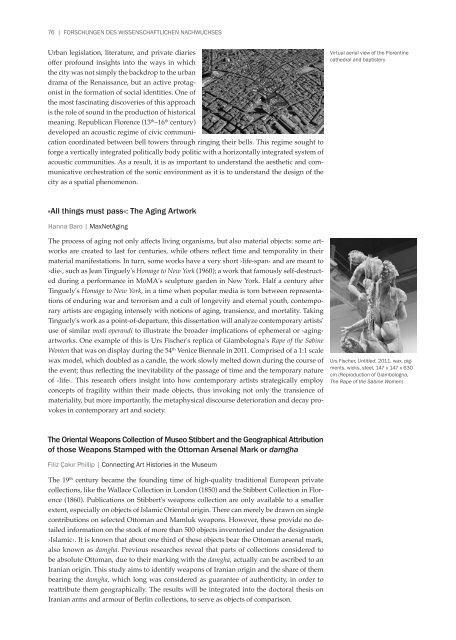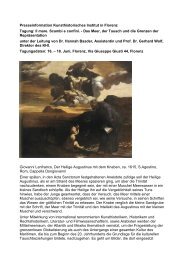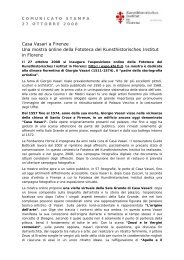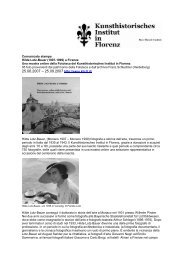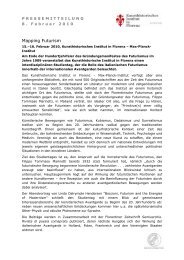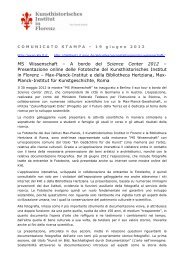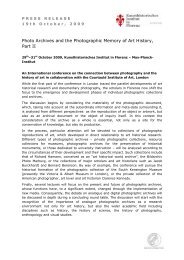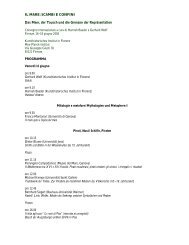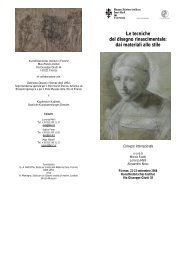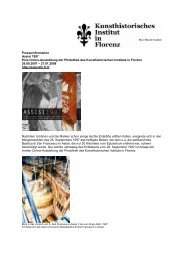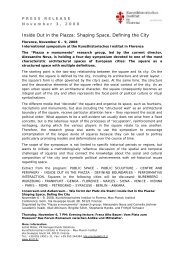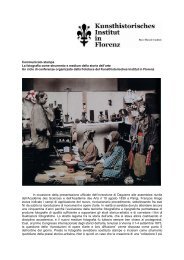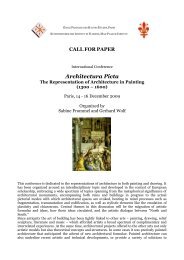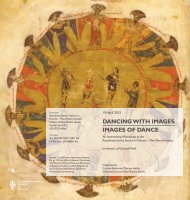forschungsbericht november 2008 – juli 2012 - Kunsthistorisches ...
forschungsbericht november 2008 – juli 2012 - Kunsthistorisches ...
forschungsbericht november 2008 – juli 2012 - Kunsthistorisches ...
Sie wollen auch ein ePaper? Erhöhen Sie die Reichweite Ihrer Titel.
YUMPU macht aus Druck-PDFs automatisch weboptimierte ePaper, die Google liebt.
76 | FORSCHUNGEN DES WISSENSCHAFTLICHEN NACHWUCHSES<br />
Urban legislation, literature, and private diaries<br />
offer profound insights into the ways in which<br />
the city was not simply the backdrop to the urban<br />
drama of the Renaissance, but an active protagonist<br />
in the formation of social identities. One of<br />
the most fascinating discoveries of this approach<br />
is the role of sound in the production of historical<br />
meaning. Republican Florence (13 th <strong>–</strong>16 th century)<br />
developed an acoustic regime of civic communication<br />
coordinated between bell towers through ringing their bells. This regime sought to<br />
forge a vertically integrated politically body politic with a horizontally integrated system of<br />
acoustic communities. As a result, it is as important to understand the aesthetic and communicative<br />
orchestration of the sonic environment as it is to understand the design of the<br />
city as a spatial phenomenon.<br />
Virtual aerial view of the Florentine<br />
cathedral and baptistery<br />
»All things must pass«: The Aging Artwork<br />
Hanna Baro | MaxNetAging<br />
The process of aging not only affects living organisms, but also material objects: some artworks<br />
are created to last for centuries, while others reflect time and temporality in their<br />
material manifestations. In turn, some works have a very short ›life-span‹ and are meant to<br />
›die‹, such as Jean Tinguely's Homage to New York (1960); a work that famously self-destructed<br />
during a performance in MoMA's sculpture garden in New York. Half a century after<br />
Tinguely's Homage to New York, in a time when popular media is torn between representations<br />
of enduring war and terrorism and a cult of longevity and eternal youth, contemporary<br />
artists are engaging intensely with notions of aging, transience, and mortality. Taking<br />
Tinguely's work as a point-of-departure, this dissertation will analyze contemporary artists'<br />
use of similar modi operandi to illustrate the broader implications of ephemeral or ›aging‹<br />
artworks. One example of this is Urs Fischer's replica of Giambologna's Rape of the Sabine<br />
Women that was on display during the 54 th Venice Biennale in 2011. Comprised of a 1:1 scale<br />
wax model, which doubled as a candle, the work slowly melted down during the course of<br />
the event; thus reflecting the inevitability of the passage of time and the temporary nature<br />
of ›life‹. This research offers insight into how contemporary artists strategically employ<br />
concepts of fragility within their made objects, thus invoking not only the transience of<br />
materiality, but more importantly, the metaphysical discourse deterioration and decay provokes<br />
in contemporary art and society.<br />
Urs Fischer, Untitled, 2011, wax, pigments,<br />
wicks, steel, 147 x 147 x 630<br />
cm (Reproduction of Giambologna,<br />
The Rape of the Sabine Women)<br />
The Oriental Weapons Collection of Museo Stibbert and the Geographical Attribution<br />
of those Weapons Stamped with the Ottoman Arsenal Mark or damgha<br />
Filiz Çakır Phillip | Connecting Art Histories in the Museum<br />
The 19 th century became the founding time of high-quality traditional European private<br />
collections, like the Wallace Collection in London (1850) and the Stibbert Collection in Florence<br />
(1860). Publications on Stibbert's weapons collection are only available to a smaller<br />
extent, especially on objects of Islamic Oriental origin. There can merely be drawn on single<br />
contributions on selected Ottoman and Mamluk weapons. However, these provide no detailed<br />
information on the stock of more than 500 objects inventoried under the designation<br />
›Islamic‹. It is known that about one third of these objects bear the Ottoman arsenal mark,<br />
also known as damgha. Previous researches reveal that parts of collections considered to<br />
be absolute Ottoman, due to their marking with the damgha, actually can be ascribed to an<br />
Iranian origin. This study aims to identify weapons of Iranian origin and the share of them<br />
bearing the damgha, which long was considered as guarantee of authenticity, in order to<br />
reattribute them geographically. The results will be integrated into the doctoral thesis on<br />
Iranian arms and armour of Berlin collections, to serve as objects of comparison.


